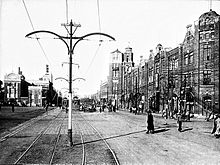Trams in Shenyang

Shenyang Trams in the 1930s
|
|||||||||
| Operation | |||||||||
|---|---|---|---|---|---|---|---|---|---|
| Locale |
Shenyang, People's Republic of China |
||||||||
| Open | 15 August 2013 | ||||||||
| Lines | 3 | ||||||||
| Infrastructure | |||||||||
| Track gauge | 1,435 mm (4 ft 8 1⁄2 in) | ||||||||
|
|||||||||
|
|||||||||
|
|||||||||
Shenyang, a major industrial city on the Hun River in northeast China has returned its tramway as a modern tram system.
Shenyang once had a standard steel wheeled tramway network. Unlike other Chinese towns & cities, Shenyang's tram system was not opened directly as an electric tram. The tram service was completely stopped in 1973. Tram returned in Shenyang in 2013.
A horse tramway was opened at Shenyang in 1907, and later the it was planned for electrification. The Japanese started electrification in March 1924, and finally electric tramway opened in Oct. 1925. From Huai door to Taiqinggong to a small west gate of the first line and opened to traffic. In November 1925, a small tram to the west gate of the opening section of the West Tower. In 1926 Sino-Japanese joint venture opened tram traffic, starting at Mukden railway station, the west end is a small door . From 1920s to 1945 accounting period ended, a total of six Shenyang tram routes was in operation.
After 1945 defeat of Japan, the country's total bipartisan see-saw fighting in Shenyang, trams run under severe impact. Civil war during the period January 12, 1946, causing the city's power supply cut off, and the tram service was suspended. In October 5, 1947, the urban power shortage, two main tram routes in East & West was suspended again. In November 1948, the KMT in Shenyang defeat, in the city days started aircraft bombing, strafing, resulting in Shenyang full 24.6 kilometers of tram 6 again outage. The PLA Shenyang Military Control Commission tissue repair Special City, November 6, 1948 Great East Gate to Shenyang station line was opened; In December 12, 1948, six routes was fully recovered.
People's Republic of China after the establishment of Shenyang has 170 trams, ranking first in the country. But a ddition of the war damage, traffic congestion also grew rapidly. Starting of bus & taxi service grew very rapidly. The number of private cars also increased very much, and especially many streets, which were ideal for tram, now started occupying by motor vehicles. Tramcars were not modernized for many decades, and basically the 1930s electric cars were still running in the 1970s. On that time buses and trolleybuses started faster & smoother journey with modern buses, whereas trams were still slower, single coach and many backdated features like trolley pole etc., so looked outdated. Under maintenance of tracks caused some derailments and bumpy rides, which were not liked by commuters. Due to the wars between China & Japan, reconstruction of Shenyang became urgent, and for this program, many streets were necessary for widening. The transport authority thought that a slow tram transport with fast bus transport on middle of a wide road will cause many problems for smoother city transportation. The tramway had little comfort and was slow because it was caught in the traffic jam caused by the cars, rickshaws etc. The tracks were also outdated, noisy and in the middle of the street. Cars had to pass the tramway on the right, causing danger for the pedestrians boarding and alighting the tramway. By justifying all ways, transport department decided to close the tram network and replace it with trolleybus service
...
Wikipedia
